LAST UPDATED: 1/26/24 – 18 Essential Pieces of Gear for Travel Photographers

NOTE: We are not being compensated in any way for any of the items or brands that we recommend. Any products or brands that we recommend, we do so because we have used and enjoyed or heard good things about them.
If you follow this blog closely, you are probably already aware that I am really, really into photography. Along with travel, it is one of my biggest passions. I never travel anywhere without a camera, and I am always looking for unique and interesting places to photograph.
If you are looking for some quick and easy tips to take great pictures on your next trip, I previously wrote a piece that I am very proud of with some excellent travel photography tips that you can find below.
| READ MORE: |
 |
| 10 Easy Vacation Photos Tips |
Although I am a firm believer that the photographer makes or breaks the picture, not the gear he or she is using, the right gear for travel photographers can definitely help you along the way.
The right gear for travel photographers can keep you organized, help make sure your camera is well maintained, and assist you in getting shots that wouldn’t be possible without the right equipment in certain conditions.
I am going to share with you some of the essential gear for travel photographers that I pack with me when I take any trip. If you have any favorite gear for travel photographers that you like to pack, please let me know in the comments section. I am always looking for gear to help me transport, protect, and take great photos while traveling!
Camera Backpack
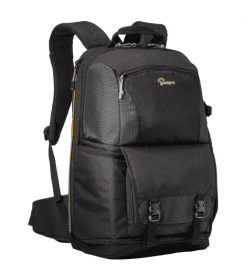
This is one of the most critical pieces of support gear for a travel photographer. Having the right backpack can mean the difference between a successful trip and trip that ends in frustration because of damaged gear. Camera bags are different than regular bags in that they are designed to transport and protect camera gear. If you are using a regular backpack or bag to carry your camera gear, you shouldn’t be. Invest in a proper camera bag and you won’t regret it in the long run.
I recommend using a camera backpack, instead of a regular bag, as it is much easier to carry your gear around in a backpack than a hand-held bag. It also allows your hands to be free when you are taking shots as well. You don’t want to have to worry about taking shots with one hand or forgetting your camera bag when you set it down to take a shot.
Personally, I am very fond of the LowePro brand of bags. I have been using them for over a decade and have nothing but wonderful things to say about their gear. However, there are a lot of great bags out there to choose from.
Before buying a bag, make sure it has enough storage to carry all of your gear. For instance, if you have two cameras that you carry, you will want to make sure the bag has enough storage for two DSLRs. You should also take into consideration the length of your lenses when making a decision on which bag is best for you.
Memory Cards and Card Reader

There is nothing worse for a travel photographer than being mid-trip and running out of space on your memory cards. You are left to wonder what magnificent shots you would have gotten if you would have only been able to take more pictures. It’s a frustrating situation that is really easy to avoid with the right gear for travel photographers.
When I travel, I make sure that I have more storage on memory cards than I think I will need. Most cameras will tell you how many pictures you can take with a memory card once you load it.
Estimate How Much Space You Will Need
Estimate how many pictures you think you will be taking on your trip, and then triple that number. You will want to make sure you have enough card space for that many pictures. It might sound excessive, but you never know what unanticipated shots you will want to take when traveling. This way, you can be very sure that you won’t run out of space.
If you are unsure as to which memory cards are best for your camera, there are some really great resources out there to assist you. Generally speaking, the first factor you are going to want to look at is the capacity of the cards. Again, it is important to make sure you have enough space to take all the pictures you want.
Don’t Forget to Consider Write Speed
Beyond the capacity, you are also going to want to take into consideration the memory card read and write speeds. If you are using a point-and-shoot camera or are shooting landscape shots, this won’t be as important of a factor. However, if you are using a DSLR and are planning to take some wildlife or action shots, then the write speed becomes a more important factor to consider.
Memory cards with a higher write speed allow you to take pictures in more rapid succession. Most DSLRs these days allow you to take pictures in bursts so that you can capture things such as an animal running or a live sporting event you are at.
If the write speed of your memory card is too slow, you might run into an issue where your camera pauses to write an image to the card even though the camera can take another picture right away. So, if you are planning on going on a safari, make sure you have the right memory cards to capture every amazing moment you see.
Memory Card Organizer
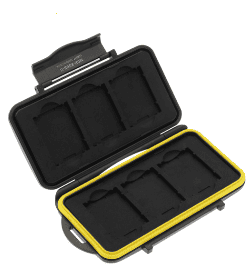
If you are going to carry extra memory cards, you are going to want to make sure that you have them neatly organized. If you can’t find your extra cards when you need them, then it really doesn’t help you much to have them.
Some camera bags will have slots that you can store your extra memory cards in, but I like to avoid using these. They don’t do as much to protect your cards as storage organizers do, and they aren’t waterproof. I would strongly suggest that you invest in a memory card organizer for your cards.
There are a variety of different brands that make these cases in a variety of different sizes. I have used Ruggard’s cases for years and have had really good luck with them. Whichever case you decide to buy, make sure that it has enough storage room for all of your cards. In addition, if you are planning to be exposed to the elements in your travels, you should also make sure that the organizer you choose is waterproof.
Travel Tripod
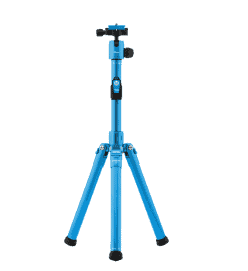
As I mentioned in my tips for taking great travel photos, one of the biggest challenges to taking great photos is overcoming camera shake. If you want to avoid blurry images, you need to make sure that your camera is still when you take your pictures.
This is especially true in low light conditions where the shutter speed is going to be slow. This is where the right gear for travel photographers can really come in handy.
Look for a Sturdy, Yet Light Tripod
The best way to keep your camera still and overcome camera shake is to use a tripod. I don’t mean one of those cheap tripods you get for free when you purchase a camera package, though they are better than nothing. You will want to invest in a sturdy, high-quality tripod if you want to get some really great shots when you travel.
In addition to the quality of build and sturdiness of the tripod, you are also going to want to make sure that your travel tripod is lightweight. The last thing you are going to want to do when you are traveling is to carry around a clunky and heavy tripod. For some tips on how to choose the best tripod for you, check out PhotographyLife.com’s guide to picking the right tripod.
Personally, I have had some very good success with the MeFOTO brand. They are very well designed sturdy, and really lightweight. They will cost you a bit more, but they should last a really long time. They even come is some fun colors instead of just boring black and grey.
Portable Hard Drive
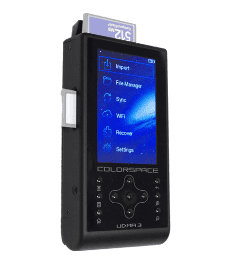
An important aspect of travel photography that often gets overlooked by beginners is backing up your photos as you go. You never know when you are going to need those backups.
Should something happen to your camera or memory cards while you are traveling, all of those beautiful pictures you took would be lost forever if you didn’t have them backed up.
Not only will a lost or stolen camera ruin your day, but the loss of all the creative pictures you worked so hard to take will add insult to injury.
Make Sure You Have a Backup Routine
That is why I strongly recommend that you implement some sort of backup routine for your pictures when you travel. This could be something as simple as copying your pictures from your memory cards over to a computer each night. However, if you don’t want to have to worry about lugging a laptop around with you when you travel, a lightweight solution would be to bring a portable hard drive.
There are many different types of portable hard drive solutions on the market today designed to make photo and video backup easy. Most of these devices are designed to read your memory cards and back them up, but some of the newer models will even back your photos up using a wireless connection.
I have found the Sanho brand to be very reliable and easy to use if you are looking for a recommendation. Whatever you decide to do, photo backup equipment is an essential part of the gear for travel photographers that you need to consider before your next big trip.
Extra Camera Batteries
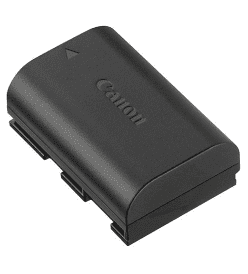
If you are going to spend a considerable amount of time out-and-about while on your trip, you are probably going to want to have some extra camera batteries with you. If you are using a point-and-shoot camera, I would definitely recommend investing in some rechargeable batteries. They might cost a bit more up-front, but they will save you a lot of money in the long-run and are more environmentally friendly.
Know How Many Batteries You’ll Need
If you are using a DSLR, this means that you are going to want to invest in a few spare batteries for your camera that you can bring along. If you are looking to purchase a new DSLR, there are plenty of camera bundles out there that throw in some extra batteries with the bundle. I would definitely recommend that you look into that before shelling out some extra cash for some more batteries.
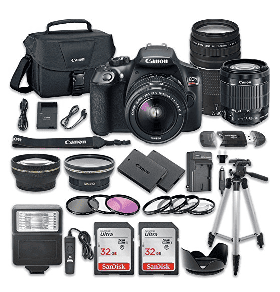
I typically bring more extra batteries than I would typically need with me when I travel because it minimizes the amount of stuff I need to charge on a nightly basis. Unless you are doing a lot of shooting, one fully charged battery should be enough to last you a full day.
If you bring four batteries with you, then you won’t need to charge batteries nearly as often. Just charge them all up before you leave, and then recharge them once or twice during your trip.
A great tip to help your batteries last longer when is to make sure you turn your camera off in between shooting. Also, unless you are shooting somewhere where you would like to track the location of your photos, turning off the GPS functionality in your camera can help too.
Battery Grip
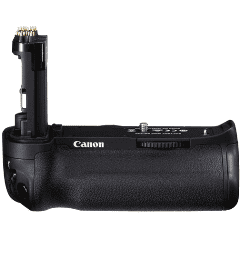
A great way to make sure you don’t run out of battery life while out-and-about for the day, without having to carry extra batteries around with you while you are out, is to use a battery grip with your camera. It is a neat piece of gear for travel photographers that is often overlooked.
A battery grip is an extension of your DSLR that holds multiple camera batteries, giving your camera more battery life before you have to change batteries. Most battery grips hold two camera batteries, which gives you twice the battery life you would have without it.
Battery Grips Make Shooting More Convenient
Another advantage of using a battery grip is that most battery grips also include a shutter button that is more convenient to use for vertical, or portrait, shots. It is a much more natural finger position when shooting in this orientation. It is so much more comfortable that I don’t like to ever take the battery grip off my camera even when I don’t need the extra battery life.
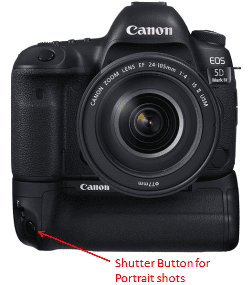
Before you rush out and purchase a battery grip, be aware that all battery grips are not compatible with all cameras. Therefore, make sure you research which battery grips are compatible with your camera before making a purchase.
Each of the major camera manufacturers produces battery grips for their DSLR cameras, but you can usually find third-party battery grips that are compatible with your camera for much less money as well.
Foreign Power Adapters
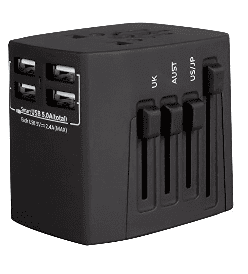
If you aren’t able to charge your camera batteries, you better have a lot of extra batteries with you on your trip. Otherwise, you may be left without a camera for much of your trip. Trust me, that is an awful feeling you want to avoid.
Having the necessary power adapters for your trip often gets overlooked when planning which camera gear to bring, as I guess you can say these adapters technically aren’t gear for your camera. However, they are critically important gear for travel photographers because your camera may be essentially useless without one.
That is why having a good travel power adapter is an essential piece of equipment when traveling anywhere outside the country. There are a variety of different adapters to choose from. Personally, I prefer models like the EPICKA – Universal Power Adapter. It has built-in adapters for over 150 different countries and includes 4 built-in USB ports for quickly charging mobile devices.
Camera Rain Gear
If you are planning to be out in the elements at all during your trip, you are going to need to make sure your camera gear is protected if it rains. Without the proper rain gear, your camera could get ruined if it is exposed to too much moisture. One option would be to put your camera in your camera bag when it rains, but that could mean missing some really great shots.
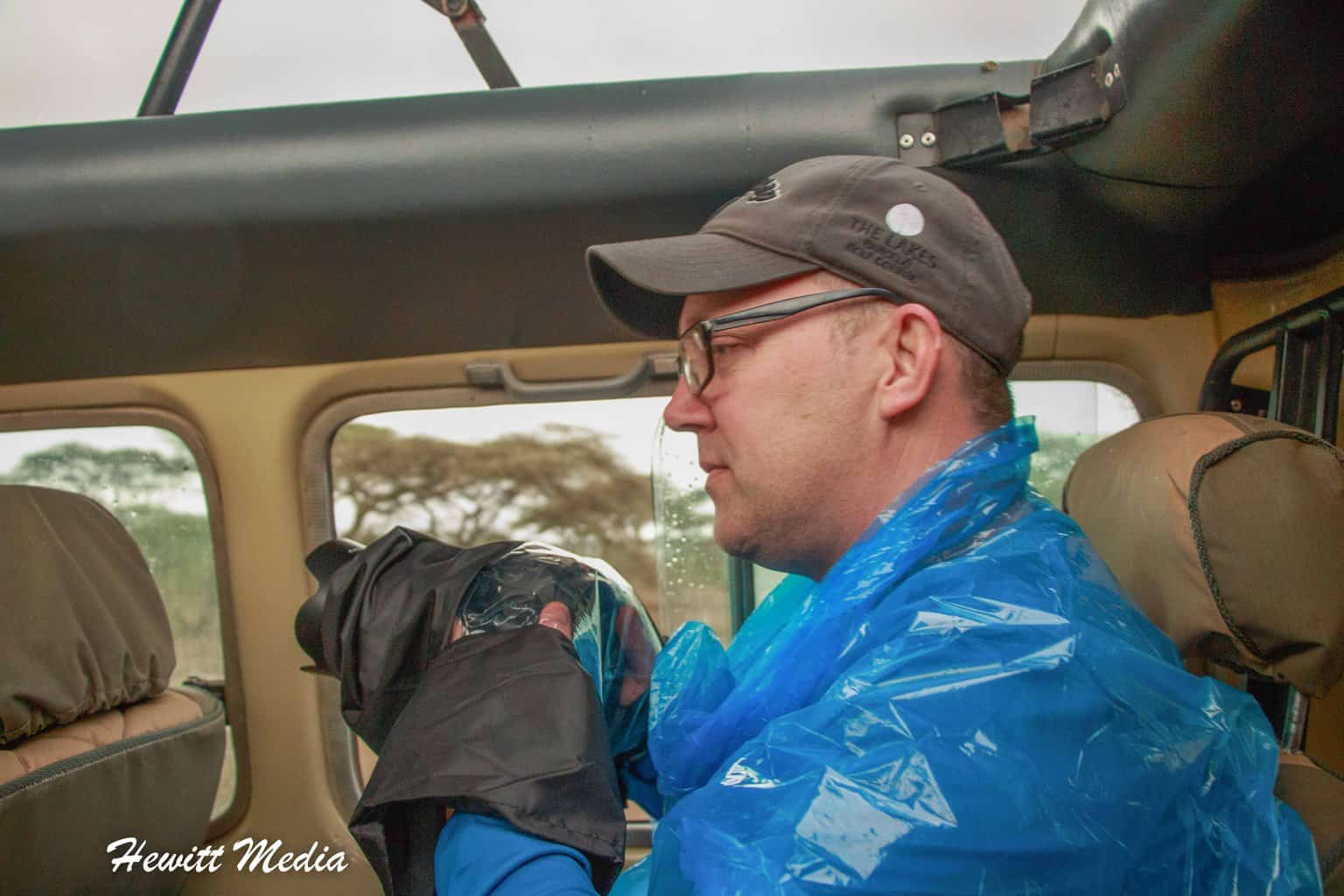
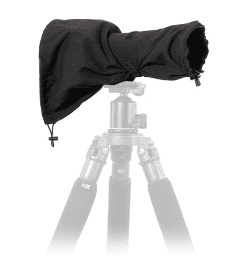
When we were in the Serengeti National Park in Tanzania, we had some pretty steady rain for nearly half a day. If I had just put my camera away in my bag, I would have missed capturing some truly memorable moments. Luckily, I had packed rain gear, not just for myself, but for my camera.
There are a variety of different rain shields that you can purchase to protect your DSLR during bad weather. Some of them are much cheaper, and disposable, while others are more costly and built to be re-used. Which option is best for you is ultimately your decision.
Camera Cleaning Gear
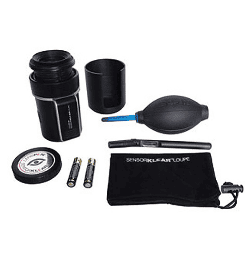
It is no secret that, as cameras get used, they get dirty. What many beginning photographers don’t realize is that a dirty camera can significantly impact the quality of your pictures.
Not only that, but a little dirt in the wrong place can be pretty difficult and expensive to clean. For these reasons, proper cleaning is an essential piece of gear for travel photographers.
If you don’t know what to look for in a good camera cleaning kit, don’t worry, I have you covered. There are some good resources out there that highlight the best cleaning kits on the market. When you are deciding which cleaning kit to purchase, make sure you factor in the size and weight.
An extensive cleaning kit is great, but it may be tough to fit into your camera bag with all of your other gear. As long as the cleaning kit has a cleaning solution, a cleaning pen or brush, and a dust blower, you should be all set.
Power Strip
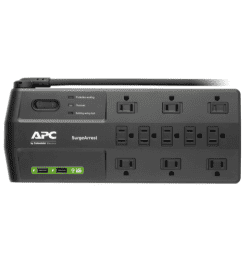
Most people who travel don’t just have to worry about charging their camera batteries at night. Most people also have a cell phone (or multiple cell phones if they are traveling with others), a tablet, and other devices that need to be charged as well.
However, depending on your hotel room, getting all of these devices charged with the available outlets (and travel power adapters) can be a challenge.
Unless you want to set your alarm for the middle of the night so that you can get up and switch the devices that are charging, you may want to invest in a travel power strip. This will allow you to charge multiple devices at once, while only using one electrical outlet and travel power adapter. Just make sure that you don’t overload the number of devices charging.
GPS Unit
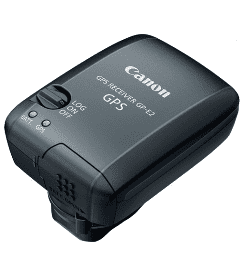
I wrote about the value of having GPS-tagged photos in our tips for taking great vacation photos. Having GPS tags on your photos can save you from a lot of frustration when you get home and can’t remember where you took certain pictures.
I know it has saved me on more than a few occasions. With the use of Adobe Lightroom, you can visibly see all of the pictures you took on a map, making it very easy to look back on pictures and remember where you were when you took them. It can even help you determine what landmarks you took pictures of.
Make Sure You Get a GPS Unit Compatible with Your Camera
Many top-of-the-line DSLRs will have GPS functionality built into the camera. However, if you don’t have a top-end DSLR, you need not worry. There are GPS units available that can add this functionality.
These devices attach to the shoe mount at the top of your camera (where you would also attach devices such as a flash). Before you go out and purchase a GPS unit, you will want to make sure that it is compatible with your model of camera. Not all GPS units are built to work with all cameras.
Head Lamp
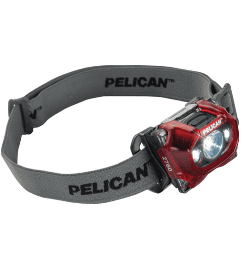
If you are planning to do some hiking or camping when you travel, then more than likely you are going to have to get into your camera bag to get some gear in low lighting. Instead of torturing yourself by looking thru a bag for some gear (or even worse, trying to change a lens) in the dark, I would strongly suggest that you invest in a head lamp.
There are a variety of different head lamps on the market, and most of them are relatively inexpensive. I would suggest that you get one that you find comfortable to wear and use. Most importantly, make sure you try it out before your trip so that you are sure that it works, and you know how to use it.
Camera Bean Bag
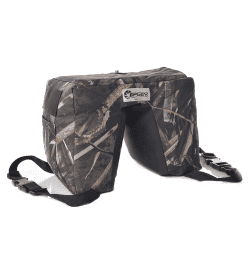
This is one of the more exotic items on the list. While it is an item that may not be absolutely necessary for every trip that you take, there are certain trips where it will be very useful.
Some situations come up in travel where you need to keep your camera relatively still while taking a shot, but using a tripod is just not feasible.
A really great example of one of these circumstances came up during our trip to Tanzania last year. While on Safari, we spent the majority of our time in our safari vehicle. There just wasn’t room in this vehicle to setup a tripod. Now, most wildlife photographers who shoot in Africa for a living will use a clamp that attaches to the vehicle to keep their camera still, it is just not practical to travel with one of these.
Bean Bags are Great When Tripods Aren’t Practical
Instead, I found that having a camera bean bag handy was a life saver. They are really good for those times when you need something to brace your camera, but space is at a premium. Not only do they keep your camera still when you need to get a shot, but they also protect your camera lens when the vehicle is moving and hits some bumps.
Camera bean bags are not just great for exotic locations such as safaris, but can also be great when traveling on a tour bus, traveling on a train, or in any other location where the use of a tripod just isn’t possible. The nice thing about these bean bags is that you can travel with them completely empty, which makes them light weight and easy to pack. Just find some beans, beads, or other bead-like material when you arrive to fill it up.
Filters
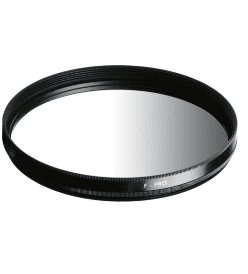
Having the right filters with you can make your job of getting the effect you want with pictures so much easier. When you are traveling, it is not always possible to wait in one spot for a long time to find the perfect light. Filters can help you adjust to the light you have so that you can get effective shots even when the light isn’t perfect.
While it is not necessary to have an elaborate set of filters with you when you travel, there are a few different filters that I would highly recommend that you invest in. The first filter that I would strongly recommend is a polarizing filter.
A polarizing filter will allow you to darken skies that may be too light because of the lighting, and they allow you to manage reflections and glare from such things as lakes and other shiny surfaces. I almost always have a polarizing filter on when I am traveling, unless I am shooting during the early morning or evening when the light is just right.
The other type of filter that can be very helpful when you are traveling is a graduated neutral density filter. These filters allow you to darken half of the shot while leaving the other half of the shot as taken without filtering. These filters are great for taking landscape shots where you might want to darken the sky in your shot but don’t want to darken the landscape.
Before you buy any filters, make sure you are getting the right size filters for your lenses. The last thing you want to do is invest in filters that you cannot use.
Lens Hoods
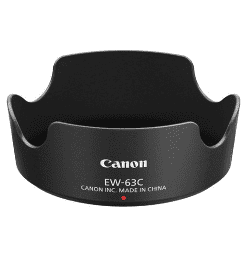
Lens hoods for your camera lenses are absolutely essential if you are planning to take pictures during the harsh light of mid-day on your trip.
Without a lens hood, lens flares (bright spots on your pictures) and blow-out highlights (spots in your picture where there is too much light to provide details) may ruin your pictures.
Lens hoods serve an additional purpose in protecting your lenses as well. More than likely there is going to be a lot of shuffling around of your camera when you travel. You’ll be taking it in-and-out of your camera bag, passing it around, and wearing it around your neck or on a shoulder strap. The lens hood will protect the most vulnerable part of the lens.
Like lens filters, you need to make sure you are getting the right size of lens hood before you make your purchase. If you don’t get the right size hood for your lens, it will not fit.
Zip Lock Bags
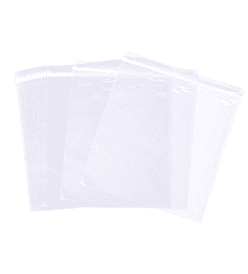
Zip lock bags may not sound like essential camera gear for travel photographers, but if you are traveling with a camera, they absolutely are. Unless your camera bag is completely waterproof, you are going to want to have them as extra protection for your camera gear against the elements. They are also really great for keeping your smaller gear organized within your bag. I have never taken a trip without some zip-lock bags.
Photography Journal
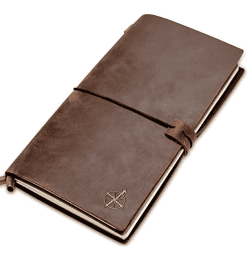
We take pictures when we travel so that we can share our adventures with others when we return. It’s frustrating when we share a picture of our journey but cannot recall all of the details behind the picture.
Even if you have an eidetic memory, we see so many amazing things when we travel that the finer details escape us after years have passed. Keeping a photo journal is a great way to cement those memories for years to come. Just spend 10-15 minutes every night writing down what you saw. You will treasure those journal entries in years to come.
Don’t Forget to Subscribe to My Adventures!

Let Me Help You Save On Your Next Adventure!
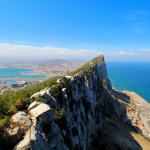




I always learn something new from you. Thanks so much for this post!
What a great and informative post! There are several things here I’m going to have to check out. I didn’t even know about the bean bags. Thanks!
No problem! Thanks for reading!
OMG! I think all that gear just filled my backpack! I am going to have to wear all my clothes at the same time! 😉 Obviously I am not a serious enough photographer! Thanks for the tips and trick, Mel
A great article; thanks for writing! I have a Nikon D40 that I sadly haven’t pulled out in some time, but I really want to get back into it. I also love to travel as well, so this article is a very useful starting point!
No problem Matthew! Glad it was helpful. Thank you so much for reading!
Very useful tips and reminders. Thank you!
Thank you so much for reading and Happy New Year!!